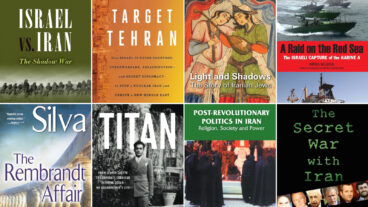Nicola Abdu, a Christian Arab who has been playing Santa for the last 18 years, visits children in a Haifa hospital.During any Saturday in December, if you walked through the market area of Wadi Nisnas in the northern Israeli city of Haifa, your senses were guaranteed to be assaulted. Mouth-watering sufganyiot (donuts for Hanukkah), knafeh (an Arab dessert), and chocolate Santa figurines lie side-by-side on the stalls. Loud speakers set up throughout the area blast out Christmas jingles, Arab pop, and Israeli rock with equal intensity.
December marks the time for the “Holiday of Holidays” Festival – an annual tradition in Haifa – in which Moslems, Christians and Jews celebrate together the holidays of Ramadan, Christmas and Hanukkah.
“Israel is home to Jews, Christians, Moslems, Bahai, Druze, new immigrants, everyone. Haifa, unlike Jerusalem or Tel Aviv, is unique in that the residents here are mixed and live day to day together in partnership,” says Hana Kofler, curator of the Beit Hagefen Jewish-Arab Center, which sponsors the event.
“Haifa is an example of successful coexistence. We try to bring people together through culture… People come from all over Israel and from abroad come to our festival to celebrate. The co-existence the festival boasts is natural to residents of Haifa.”
The spirit of the holidays this year reached far and wide – as thousands of people descended on the city for the free event.
“It didn’t matter that it was raining and cold some weekends,” says Kofler, “people still came in droves.”
The festival featured installations by Arab and Jewish artists in alleys and on walls of houses in the multi-ethnic neighborhood of Wadi Nisnas; an antiques fair; programs for children; Liturgical concerts; dance productions; poetry exhibits; and a coexistence walk through the German Colony and Wadi Nisnas. One of the top draws of the festival is Santa’s house.
Nicola Abdu, a Christian Arab, has been playing Santa for the last 18 years. His home is decked out with a fully trimmed Christmas tree, and guests are invited to sit and chat with the roly-poly man donning a red-and-white Santa uniform for the occasion. Visitors are given candies upon arrival. Taking up much of the room on his balcony are boxes filled with wrapped gifts for hospitalized children.
“We give gifts to Jews, Moslems and Christians,” says Abdu. “It doesn’t matter what religion the kids are. Children are children.”
Callers sitting down to hear his story are greeted with Turkish coffee. Abdu passes around a photo album of his visits to hospitals.
“We teach the children that there’s no difference between a Moslem and a Jew and a Christian. It’s too bad we can’t teach adults the same thing,” he says. “Meeting Santa [Abdu] was the highlight of my day,” said Irit Shabat, a Jewish visitor from Tel Aviv. “He is a very interesting man and his work is awe-inspiring.”
Down the narrow road from Santa’s house, the co-existence walking routes crisscross one another. The routes, which are open all year, are divided into four: Art Works Route, Poetry Path, author Emile Habibi’s Route, and writer Sammy Michael’s Route. “The art dispersed around the Wadi was also engaging,” said 29-year-old Shabat.
Every year Beit Hagefen invites 100 artists to exhibit their sculptures, photographs, paintings, and installations throughout the Wadi Nisnas alleys and at the Beit Hagefen Art Gallery. This year’s theme was “Utopia”. The center offers guided tours year-round of the Arts Works Route in Hebrew, Arabic, English, Russian, German, French and Spanish (Fax: +972 4 8529166; bhagefen@netvision.net.il).
“The outdoor art really livens up the area,” said Kofler. “The feedback that we get is that people really like the Art Works Route.” The other three routes feature Arabic and Hebrew poems and excerpts (translated from one language to the other) printed onto billboards and placed around the area. The art along the coexistence walking routes, according to the festival’s pamphlet, “symbolizes hope for a better future.”
“It’s a fun day out,” said Daniel Kaufman, 34, as to why he came to the festival. “There is a good atmosphere. People are enjoying themselves. That’s what the holidays are all about.”












